Kelly Ludwig is a designer, photographer, and advocate for art environments and folk artists based in Kansas City, Missouri.
When we wanted to know a little bit more about what inspires her to drive cross-country, pull over when she sees something interesting and knock on strangers' doors to learn more—she generously took time to answer our questions and share her experience. Kelly has gifted more than 58,000 images taken on her many road trips across the country as well as 3,636 artist files with research she conducted to the SPACES Archives—thank you, Kelly!
Ludwig blends her passion for photography, design, and travel with technology, and has created two award-winning travel apps. Detour Art, Travel-o-Pedia, and Home Court Advantage are just a few of the titles she has authored, shot, and designed. Her photographs have been exhibited globally including the Abby Aldridge Rockefeller Folk Art Museum, SFO Museum in San Francisco, WeeGee Exhibition Centre in Espoo, Finland, the Museum of Everything in London, and the American Folk Art Museum in Brooklyn. Kelly has been designing professionally since graduating from the University of Kansas with a B.F.A. in Visual Communications. Prior to her current role as Group Creative Director of Design at DEG Digital, she was at the Kansas City Art Institute as an assistant professor and interim chair of the graphic design department.
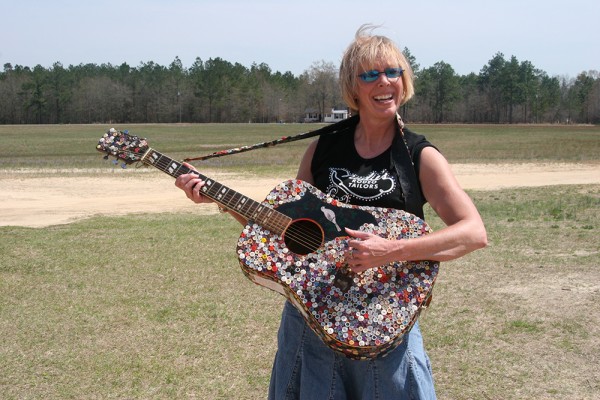
Kelly Ludwig poses with (plays?!) the Button King's (Dalton Stevens) guitar.
How did you discover the world of art environments?
It is hard to say when the exact moment was. I grew up in the Ozarks, and loved to drive around the back roads. I saw the tree that had coffee mugs nailed to it, and was struck by the intent.
In college, we had an assignment to design a brochure for the Kansas Grassroots Art Association and were provided a list of environments to include. I “had” to go see the places. While the obsession didn’t take hold then, the seed was planted.
Later, I had the great fortune to meet the guys from the Kansas City based PBS show Rare Visions and Roadside Revelations who introduced me to artist-created environments. They needed a book designer for their first book. (I am a designer by trade.) I quickly discovered that they also needed photographs since they had only been shooting video. (I am a photographer by passion.) Next thing you know I am on the road with the show for eight years, meeting the artists and their creations. Even though the show was cancelled years ago, I still hit the road as often as I possibly can.
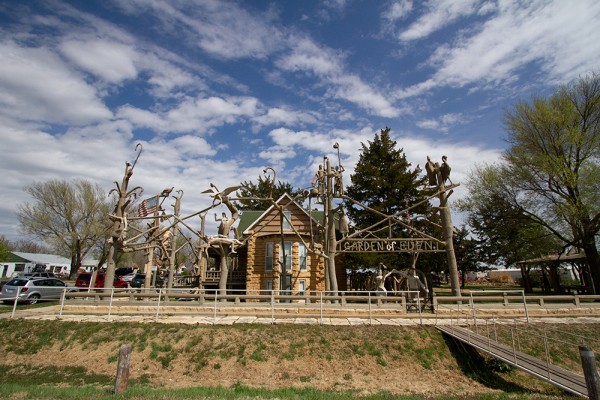
The Garden of Eden in Lucas, KS.
What were the first sites you visited and what about them made you want to learn more?
The Garden of Eden in Lucas, Kansas, was the first jaw-dropping environment I saw. The narrative that it weaves around the property reinforced the notion of the storytelling power of art. Dinsmoor engaged people with his art to get them to “see” his point of view about the world (populist politics and religion).
Robert Dorris’ Dinosaur Not-So-National Park in Erie, Kansas, was the first time I got to meet the creator in their environment–a completely different site and experience. He was a retired Air Force engineer who started to create life-sized welded dinosaurs from scrap metal for his daughter, inspired by their visit to the Smithsonian Museum of Natural History.
Then there is MT Liggett’s Sign Field. Still telling a personal story, and what a story it is. Personal, political, scathing, and loving.
All completely different motivations, stories, and environments less than 300 miles apart. I was hooked. Still am.
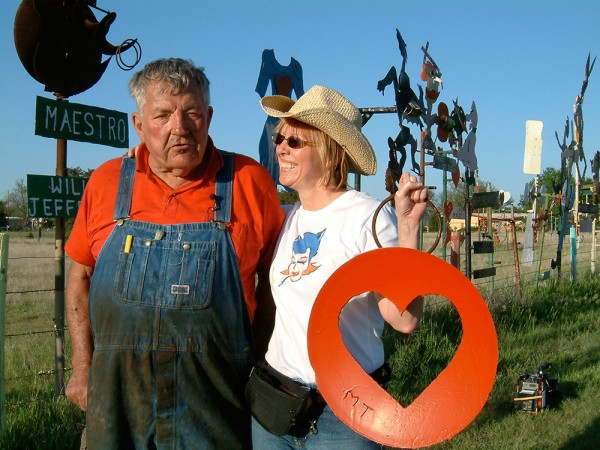
Kelly Ludwig and M.T. Liggett
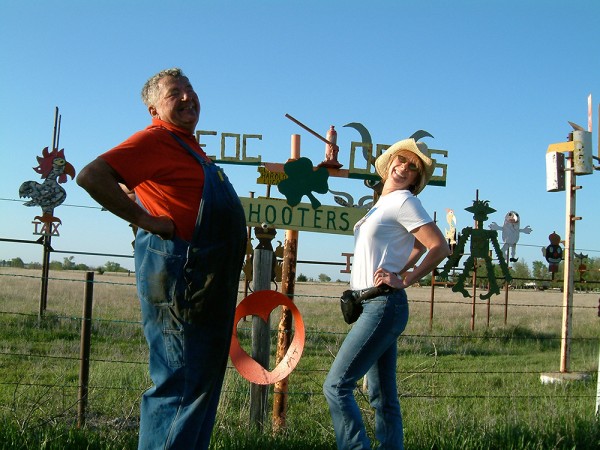
Kelly Ludwig and M.T. Liggett pose in front of his creations along US 400 in Mullinville, KS.
Tell us about your favorite sites.
I can’t narrow it down to one, so here are my top three Midwestern sites:
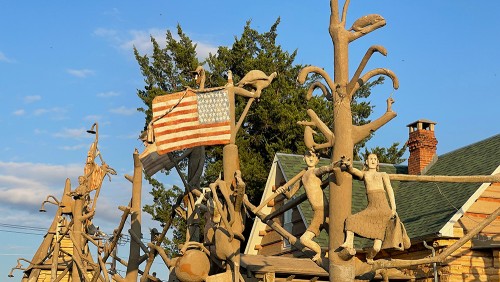
S.P. Dinsmoor’s Garden of Eden
As I mentioned earlier–I love it so much, I am on the board. It is the oldest intact artist-built environment in the U.S. This was the first environment that I really fell in love with. The place where I realized that there is something very cool happening on the backroads.
This jaw-dropper is the oldest complete folk art environment in the United States, creating a creative epicenter in this rural Kansas town. Okay, it’s not exactly the garden in the Bible, but Samuel P. Dinsmoor began pouring forth his vision in 1907 when, at the age of 64, he completed his Log Cabin Home, built from native limestone. Then, using the newest building compound of its day–concrete–he spent the next 18 years surrounding his house with a narrative sculpture garden. He was a Civil War veteran and one of those Kansas populists who liked to ruffle the status quo. Dinsmoor also just happened to have an amazing eye for sculpting. Serpents, soldiers, Adam, Eve, the crucifixion of labor by societal forces . . . it's all up there, enduring harsh Midwestern heat and cold, while Dinsmoor himself lays on display in his coffin in a mausoleum out back. Populists believed that humor could help get people's attention, and the sheer audacity of the Garden must have brought a lot of grins.
The Garden was also the first place in town to have its own electric generator to power the lights. The night train running from Kansas City to Denver, seeing the glow on the horizon, would stop to let passengers off for a while to marvel at the site and get a good dose of Kansas populist preaching. But the town wasn't always crazy about it. At one point, there was serious talk of bulldozing the Garden down. Luckily, cooler heads prevailed, and in 2011, the fine folks from Kohler Foundation came down and restored the Garden to Dinsmoor’s vision.
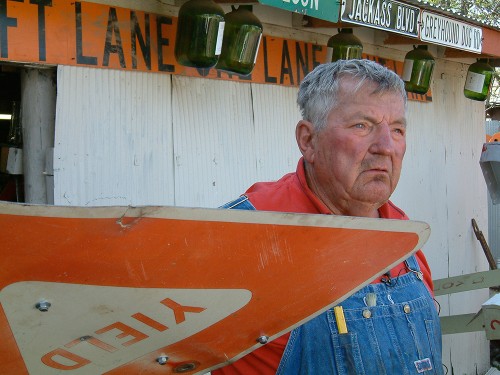
A portrait of M.T. Liggett by Ludwig.
M.T. Liggett’s Sign Field
M.T. Liggett was a character who I felt very much at home with. Outspoken and creative, he never shied away from expressing his opinions via his art. His sign field is a whirling, colorful testimony to his orneriness and talent. (Much to the chagrin of his neighbors and politicians that crossed paths with him.)
It all started with a gargoyle to protect his horse, next a less than flattering caricature of a county commissioner, then another, and another. Soon, M.T. Liggett’s welded social commentary took root on his farm just outside Mullinville, Kansas.
In 1989, after a career in the Air Force, M.T. returned to the farm where he was born. There he began creating fantastic, sometimes kinetic, “totem poles” from scraps of metal, old car parts, road signs, and just about anything else he found. Now stretching almost a mile along Route 400, his garden of goat-getting political satire keeps the town folks at the local diner irritated. “I say what I want to say, and I piss a lot of people off.” Beneath his gruff exterior was an extremely intelligent and talented man who had volumes to say.
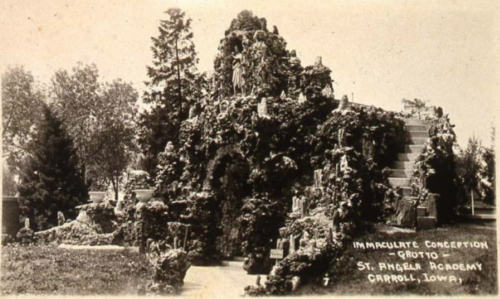
A vintage "real photo" postcard of a grotto by Father Dobberstein
Father Paul M. Dobberstein’s Grotto of the Redemption
This grotto is the epicenter of midwestern grottos and inspiration for so many other artists. The eighth wonder of the world is in Iowa. Grottos are a phenomenon I've seen a lot of over the years, but this one is King of the Hill. While a student at a seminary Father Paul Dobberstein became seriously ill with pneumonia and promised to honor the Blessed Virgin should he recover his health. He kept it in a big way!
Assigned to the West Bend parish, he began digging the footings for his grotto by 1901. He worked with rocks, minerals, crystals, and concrete, hauling materials by the railcar-load. Father Paul had studied geology during his student years and prized working with the finest minerals. He and his helpers built and built and built. Pathways wind in and around the grounds, leading one through a maze of religious riches. The grotto, the story of the Redemption, the caves honoring the Blessed Mother, the Twelve Stations of the Cross, and on and on, are all woven together in a tapestry of gilded stone.
Road tripping was a new phenomena at this time, and people would flock to see this incredible display of devotion, then return to their towns (or farms) and create their own. It was like the “telephone game.” Each place would add their own touches, be it different materials or ideology, secular, religious, or a combo of the two. Dickeyville and the Wegner grottoes are prime examples of this. I could go on and on, Lisa Stone is the true expert here.
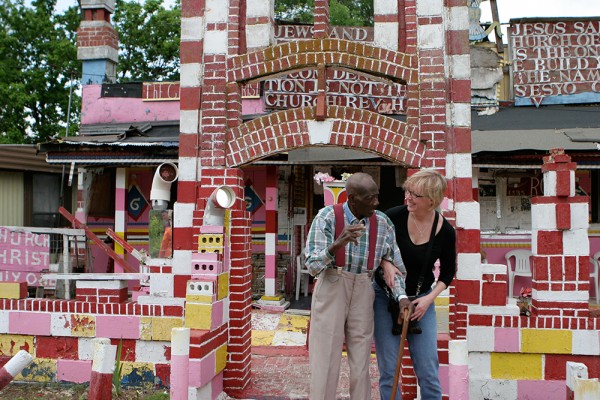
Reverend Dennis and Kelly Ludwig outside of Margaret's Grocery in Vicksburg, MS.
What's the best part of road tripping? What advice would you give to folks who are interested in starting?
The best part is … all of it! I am a journey person, not a destination person. I love driving because I am not in front of a computer screen, I can stop when I want (meaning it takes me longer to get there), and it gives me time to think. I’ll choose either music, podcasts, or books that are regionally specific to get me in the groove.
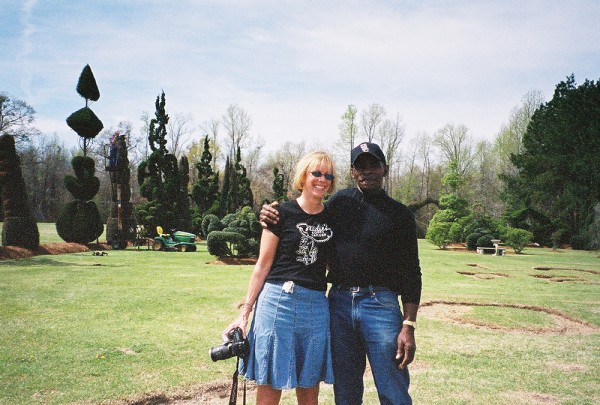
Kelly Ludwig and Pearl Fryar, topiary artist.
Planning:
Years ago I created a road trip app. I still have a big database that I refer to before I go and continuously add to. (Sadly, there was a big technology update, and I couldn’t swing it financially to keep the app live). Research and serendipity.
Now, I really like using roadtrippers.com to plot the path. (It is great that they will show you what is nearby). Once you have your path plotted, it is super easy to use your favorite map app. Roadside America is a lot of fun as well, and the user tips can be good to find lesser known places (and goofy stops as well).
Google Street View can help with taking the best photos. Here you can see if the place is facing east, making it a great stop in the mornings, etc. My good friend Larry Harris is a genius on Google Street View and has found so many cool places before even starting the car. Plus, he is my phone-a-friend when I see something that I am not sure of or if there is something nearby I must see.
Driving:
Once I have a handful of destinations, I set my phone maps to “no highways” between sites, and it will take me on routes I never expected. (Yes, gravel roads are included.) I am not in a hurry. I’ll catch something out of the corner of my eye, debate turning around for about 3 seconds, then head back to see what I just drove past.
Visiting:
Probably the most important piece of advice is to remember that often these places are on private property, so don’t trespass. Be respectful of the place and the people. Meet them where they are–this is their passion. You may not “get” it at first, so ask them about why they made what they did. Even the most seemingly chaotic of places have had each piece placed in its location for a reason.
If I can, I try to contact folks beforehand–but truthfully, I never know for sure when I will arrive, and I hate when people are waiting for me. So a lot of the time, I just show up. Master photographer Fred Scruton is much, much better about pre-planning and will spend a lot more time at each site to get the perfect light and really get to know the artists. I could learn a thing or two from him.
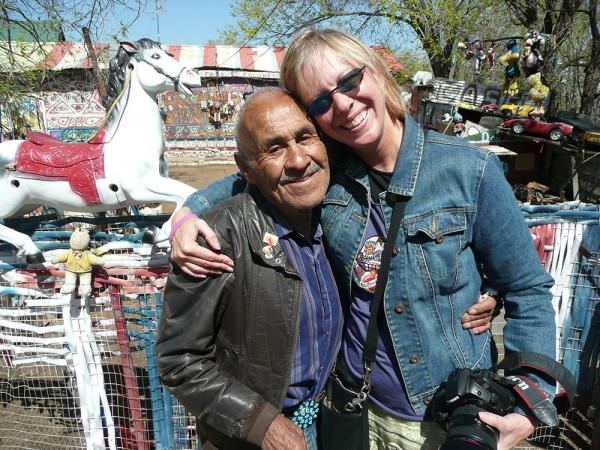
Environment builder Casey Marquez and Kelly Ludwig outside Marquez's Casa de Colores
What are you up to these days? What sites would you like to see next and/or revisit?
I recently returned from a trip through the midwest to Wyoming and “discovered” two new-to-me artist-built environments. Neither has been documented, so now I am doing research to learn more. I might have to go back.
I would like to revisit Joe Minter’s place in Birmingham, Alabama, and Dr. Charles Smith’s place in Hammond, Louisiana. I suspect that they have added new pieces in light of today’s political climate. I “need” to get back to L.A. to see the renovations on Watts Towers.
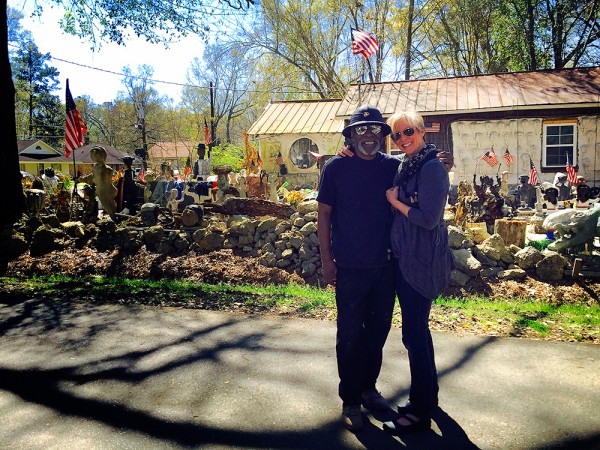
Dr. Charles Smith and Kelly Ludwig at the African American Heritage Museum and Black Veterans Archive.
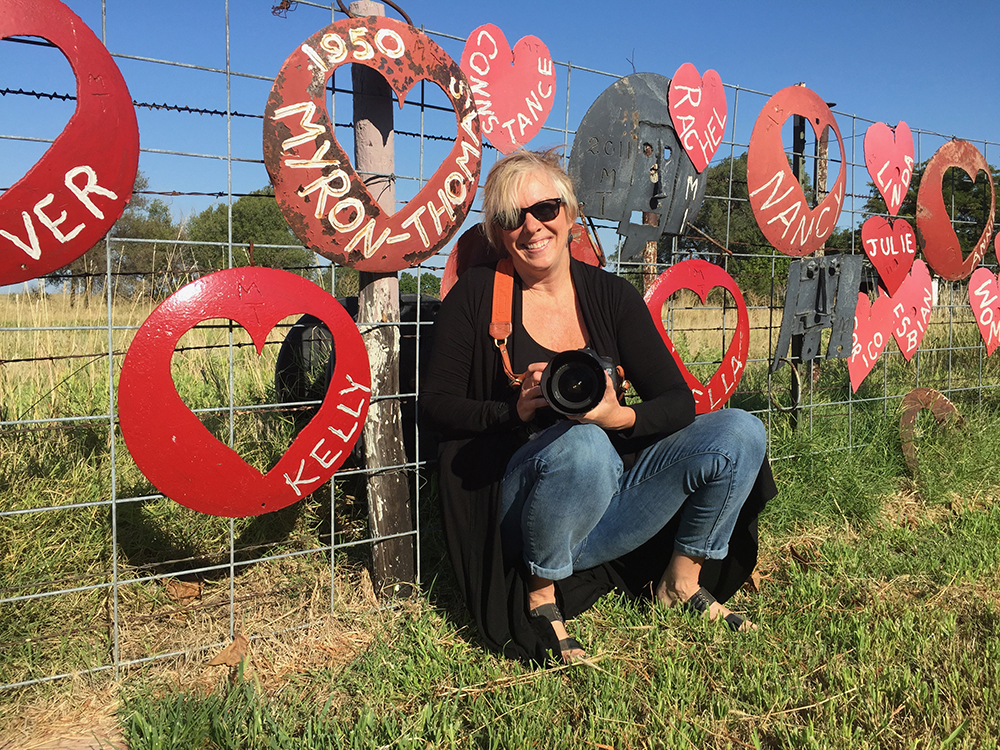

Post your comment
Comments
derkevics ed January 9, 2022
I absolutely love folk art environments. Have you ever visited SHAMC and tha Whimzeyland House in Safety Harbor, Florida? They also have some great Folk Artists like Natty Moss Bond, Debbie Klein, And me, Ed Derkevics/Ed'sShed
Fred Scruton December 24, 2021
Thanks for the shout-out Kelly, but you are the pioneer, the inspiration for all us Sally-and-Johnny-come-lately art environment road warriors. Seeing your and Larry's photographs when I was first getting started made me realize that art environment photography could be thing-- and a thing with endlessly rewarding possibilities. And thanks for your incredibly generous donation to SPACES; all of our work becomes more precious as time slips away-- with so many of your pics, I say, "thank goodness Kelly was there to get that, and get it so well."
PHILLIP FOUNTAIN December 21, 2021
Kelly is a personal friend and a treasure! So happy to see her recognized in this way!